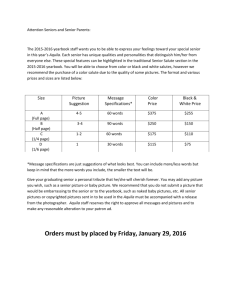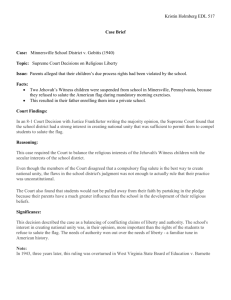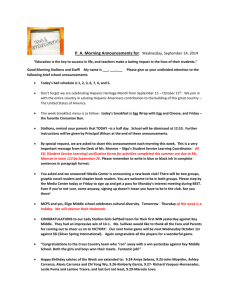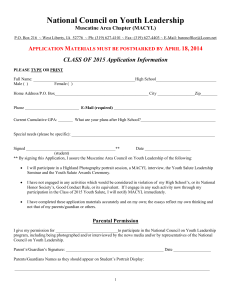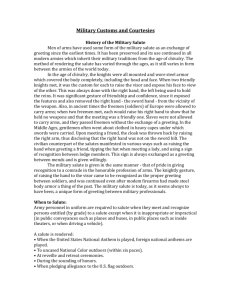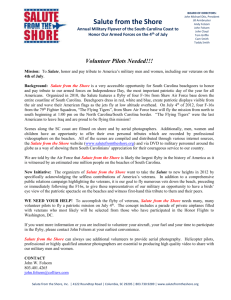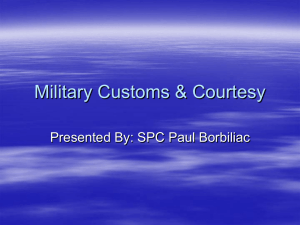US Military Customs and Courtesies
advertisement
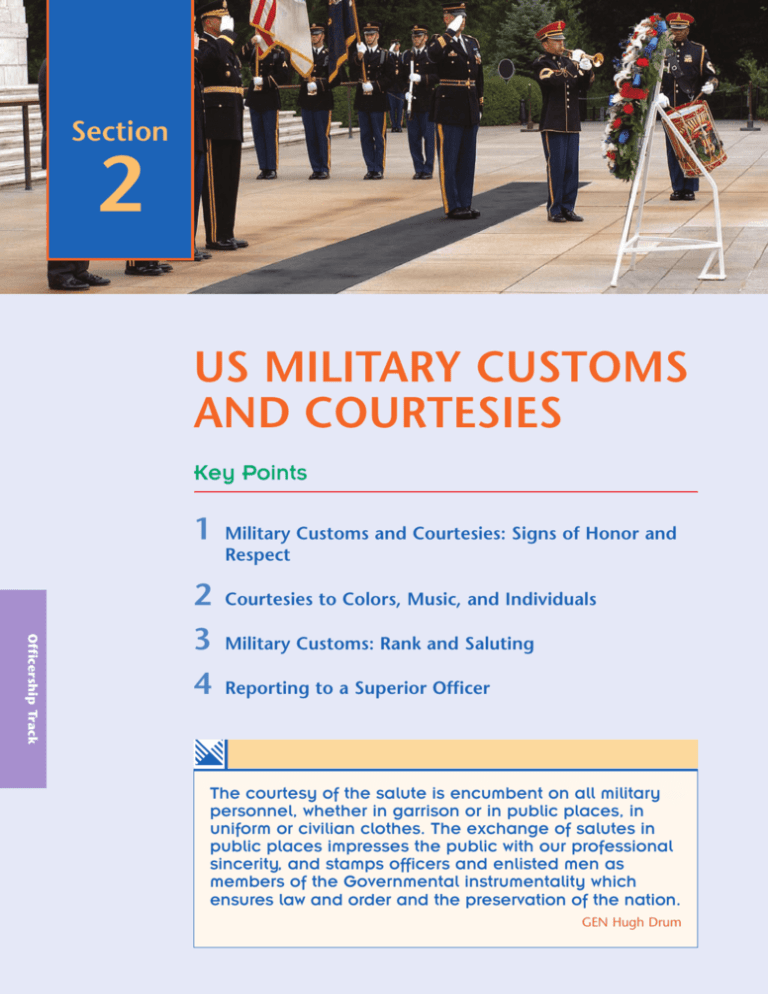
Section 2 US MILITARY CUSTOMS AND COURTESIES Key Points 1 Officership Track 2 3 4 Military Customs and Courtesies: Signs of Honor and Respect Courtesies to Colors, Music, and Individuals Military Customs: Rank and Saluting Reporting to a Superior Officer e The courtesy of the salute is encumbent on all military personnel, whether in garrison or in public places, in uniform or civilian clothes. The exchange of salutes in public places impresses the public with our professional sincerity, and stamps officers and enlisted men as members of the Governmental instrumentality which ensures law and order and the preservation of the nation. GEN Hugh Drum US Military Customs and Courtesies ■ 129 Introduction A custom is a social convention stemming from tradition and enforced as an unwritten law. A courtesy is a respectful behavior often linked to a custom. A military courtesy is such behavior extended to a person or thing that honors them in some way. Military customs and courtesies define the profession of arms. When you display military customs and courtesies in various situations, you demonstrate to yourself and others your commitment to duty, honor, and country. As a Cadet and future Army leader, you must recognize that military customs and courtesies are your constant means of showing that the standard of conduct for officers and Soldiers is high and disciplined, is based on a code akin to chivalry, and is universal throughout the profession of arms. Military Customs and Courtesies: Signs of Honor and Respect Every branch of the armed services has a variety of characteristic customs established long ago and still in use today. Army customs and courtesies lend color, distinction, and ceremony to your daily life as a Soldier. Courtesies are the outward signs of your respect for your nation, your flag, your comrades, and our country’s fallen heroes. They engender mutual respect, good manners, politeness, and discipline. Customs include such things as responding to a senior officer’s presence, recognizing the officer’s rank or position of honor, correctly using military titles, wearing headgear, saluting appropriately, reporting correctly, and honoring national and Army symbols and music. Courtesies to Colors, Music, and Individuals Courtesies to Colors National and organizational flags that fly from flagstaffs equipped with finials (the decorative top pieces), are Colors. When not in use, Colors are furled and encased to protect them. The military detachment assigned to protect, carry, and display them is called a color guard. When you pass an unfurled, uncased national Color, salute at six steps’ distance, and hold the salute until you have passed six steps beyond the flag. Similarly, if the uncased Color passes by, salute when the flag is six steps away and hold the salute until it has passed six steps beyond. You shouldn’t salute small national flags carried by individuals, such as those carried by civilian spectators at a parade or printed on solid objects. It’s also improper for you to salute while you have any object in your right hand or a cigarette, cigar, or pipe in your mouth. Courtesies to Music Military music dates back to the early Roman times when such music called military formations together. Now military music establishes a sense of alertness, urgency, attention to detail, self-discipline, and confidence. Outdoors, whenever and wherever the United States National Anthem, “To the Color,” “Reveille,” or “Hail to the Chief ” is played, at the first note, all Soldiers in uniform and not in formation face the flag—or the music, if the flag is not in view—stand at attention, military courtesy the respect and honor shown to military traditions, practices, symbols, and individuals military customs those time-honored practices and outward signs of military courtesy that create a formal atmosphere of respect and honor 130 ■ SECTION 2 The National Colors and the Army Colors are followed by organizational colors. and give the prescribed salute. Hold the salute position until the last note of the music sounds. Military personnel not in uniform will stand at attention, removing headgear, if any, and place the right hand over the heart. Vehicles in motion come to a halt. Soldiers riding in a passenger car or on a motorcycle dismount and salute. Occupants of other types of military vehicles and buses remain in the vehicle; the individual in charge of each vehicle dismounts and renders the hand salute. Tank and armored car commanders salute from the vehicle. Indoors, when honoring the US flag, national anthem, and bugle calls, officers and Soldiers stand at attention and face the music or the flag, if one is present. Other songs worthy of respect and honor include “The Army Song,”“Stars and Stripes Forever,” “America the Beautiful,” and “God Bless America.” Bugle calls are another form of military music to which you should respond with attention. These include: • • • • • • Attention, Assembly, Adjutant’s Call Carry On, Mess Call, Recall Taps, Tattoo To the Color, National Anthem Sound Off, 1st Call Reveille and Retreat. Courtesies to Individuals The expression “under arms” means carrying a weapon in your hands, by a sling, or in a holster. You show respect for people by standing when they enter a room or enter a conversation. When not at attention or saluting, you allow officers the position of honor at a table. These informal gestures demonstrate your character and respect for Army Values. Uncovering—removing a beret, hat, or headgear—isn’t just good manners; it’s a sign of respect to others. You should remove your headgear indoors, unless you are under arms. Officers and enlisted Soldiers uncover when they sit as a member of or in attendance on a court or board, when entering places of divine worship, and during attendance at an official reception. US Military Customs and Courtesies ■ 131 Figure 2.1 Military Rank Progression Outdoors, you should not remove your military headgear nor raise it as a form of salutation. Military Customs: Rank and Saluting Military Rank For thousands of years, in almost all cultures, leaders have worn or held symbols of their position and authority. In ancient Rome, magistrates carried the fasces, a bundle of rods with an axe protruding, as a symbol of their power. Native American chiefs donned eagle feathers to represent their bravery and status in the tribe. So it’s natural for the Army to have rank: Insignia of rank identify who is in charge. The US Army adapted much of its rank structure from the British military tradition. Military rank—unlike a pay grade, which is an administrative feature—is a visible mark of responsibility and leadership meriting recognition and respect. The customary way you recognize an officer of superior rank is to salute him or her. The Military Salute The origin of the military salute is uncertain, but it probably began as a gesture of trust to show that a person was not holding a weapon. Some historians believe saluting began in Roman times when assassinations were common. A citizen who wanted to see a public official had to approach with his right hand raised to show that he did not hold a weapon. Knights in armor raised their visors with the right hand when meeting other knights. This practice gradually became a way of showing respect and, in early American history, sometimes involved removing one’s hat. By 1820, the motion had become touching the hat and, since then, the gesture has evolved into the hand salute used in the military today. military salute a formal, one-count military gesture of respect given at attention, in which a subordinate acknowledges a superior officer by bringing the hand to the brim of the cap or to a point slightly above the right eye— Soldiers salute in greeting, leaving, reporting, and other military situations to publicly show respect for the superior’s rank 132 ■ SECTION 2 When to Salute A salute is a public sign of respect and recognition of another’s higher rank. When in uniform, you salute when you meet and recognize an officer entitled to a salute by rank except when inappropriate or impractical. Generally, in any case not covered by specific situations, a salute is the respectful, appropriate way to acknowledge a superior officer. Times you should salute include: • When the US National Anthem, “To the Color,” “Hail to the Chief,” or foreign national anthems are played • When you see uncased National Colors outdoors • On ceremonial occasions • At reveille and retreat ceremonies during the raising or lowering of the US flag • During the sounding of honors • When the Pledge of Allegiance is being recited outdoors • When relieving an officer or turning over control of formations • When rendering reports • When greeting officers of friendly foreign countries • When you see officers in official vehicles. When Not to Salute You don’t have to salute indoors, except when you report to a superior officer. If either person is wearing civilian clothes and you do not recognize the other person as a superior officer, salutes are unnecessary. Use common sense. If you are carrying something with both hands or doing something that makes saluting impractical, you are not required to salute a senior officer or return a salute to a subordinate. A simple greeting of the day, “Good morning, Sir (Ma’am),” is acceptable and encouraged. Use your judgment. You don’t have to salute in an airplane, on a bus, when driving a vehicle, or in public places such as inside theaters or other places of business. The driver of a moving vehicle does not initiate a salute. Sometimes saluting is inappropriate. Soldiers participating in games and members of work details do not salute. Soldiers reporting to an NCO do not salute. How to Salute The hand salute is a smart, one-count movement at the command “Present, arms.” When wearing headgear with a visor with or without glasses, on the command of execution “arms,” raise the right hand sharply, fingers and thumb extended and joined, palm facing down. Place the tip of the right forefinger on the rim of the visor slightly to the right of the right eye. The outer edge of the hand barely cants downward, so that neither the back of the hand nor the palm is clearly visible from the front. The hand and wrist are straight, the elbow inclined slightly forward, and the upper arm horizontal. A well-executed salute is crisp, quick, and immediate, with both subordinate and senior officer making the movement in a professional gesture of respect and recognition of that respect. Saluting should become a reflex to you. Saluting People in Vehicles You should practice the appropriate courtesy of saluting officers in official vehicles, recognized individually by grade or by identifying vehicle plates and/or flags. You don’t salute officers or return salutes from subordinates who are driving or riding in privately owned vehicles. US Military Customs and Courtesies ■ 133 Greeting an officer Saluting in Formation In formation, you don’t salute or return salutes except at the command “Present, arms.” An individual in formation at ease or at rest comes to attention when addressed by an officer. In this case, the individual in charge salutes and acknowledges salutes on behalf of the entire formation. Commanders of units that are not a part of a larger formation salute officers of higher grade by bringing the unit to attention before saluting. When under battle or simulated battle conditions, you should not call your unit to attention. Saluting Out of Formation When an officer approaches a group of individuals not in formation, the first person noticing the officer calls everyone present to attention. All come sharply to attention and salute. If you are in charge of a work detail, but not actively engaged, you salute and acknowledge salutes for the entire detail. A unit resting along a road does not automatically come to attention upon the approach of an officer. If the officer speaks to an individual or the group, however, the individual or group comes to attention and remains at attention—unless otherwise ordered—until the conversation ends, at which time the individual or group salutes the officer. Reporting to a Superior Officer Reporting Indoors When reporting to a superior officer in his or her office, the Cadet, officer, or Soldier removes headgear, knocks, and enters when told to do so, approaches within two steps of the officer’s desk, halts, salutes, and reports, “Sir (Ma’am), Cadet Jones reports.” Hold the salute until your report is complete and the officer has returned your salute. At the end of the report, you salute again, holding the salute until it is returned. Then you smartly execute the appropriate facing movement and depart. When reporting indoors under arms, the reporting the procedure for approaching and speaking to a superior officer that includes approaching, standing at attention, saluting, politely addressing the officer, waiting for recognition, and concisely giving the necessary report, message, or briefing 134 ■ SECTION 2 e Critical Thinking What could be one practical purpose of the reporting procedure? Why might such formal address be necessary to good order, clarity, and precision in the field? procedure is the same, except that you don’t remove your headgear and you render the salute prescribed for the weapon you are carrying. When a Soldier reports to an NCO, the procedures are the same, except that the two exchange no salutes. Reporting Outdoors When reporting outdoors, you move rapidly toward the senior officer, halt approximately three steps from the officer, salute, and concisely make your report, as you do indoors. When dismissed by the officer, you exchange salutes again. If under arms, you should carry your weapon in the manner prescribed for saluting with that weapon. (See FM 3–21.5, Appendix A.) US Military Customs and Courtesies e CONCLUSION The disciplined exercise of military customs and courtesies in an organization is a clear indicator of the morale and leadership of that organization. It also indicates an organization’s ability to function under stress as a team of professionals bound by a warrior ethos and mutual respect. As an ROTC Cadet, you acknowledge your place in the profession of arms through your crisp, professional exercise of customs and courtesies—smartly saluting, properly reporting, and otherwise showing appropriate signs of honor and respect. Learning Assessment 1. While listening to Army music, songs, and bugle calls, demonstrate your ability to stand at attention, salute, report, and uncover at appropriate times by role-playing with classmates. 2. Name three times when you are required to salute a superior officer and three times when saluting is unnecessary. 3. What is the difference between a flag and a Color? 4. What is the difference between a courtesy and a custom? Give an example of each. 5. Explain the purpose of military rank. Key Words military courtesy military customs military salute reporting References AR 600–25, Salutes, Honors and Visits of Courtesy. 24 September 2004. Field Manual 3–21.5, Drill and Ceremonies. 7 July 2003. Field Manual 670–1, Wear and Appearance of Uniforms & Insignia. 3 February 2005. US Army Military History Institute. (November 1989). The Hand Salute: A Working Bibliography of MHI Sources. Carlisle, PA. Retrieved 18 July 2005 from http://carlislewww.army.mil/usamhi/Bibliographies/ReferenceBibliographies/customs/salute.doc ■ 135
